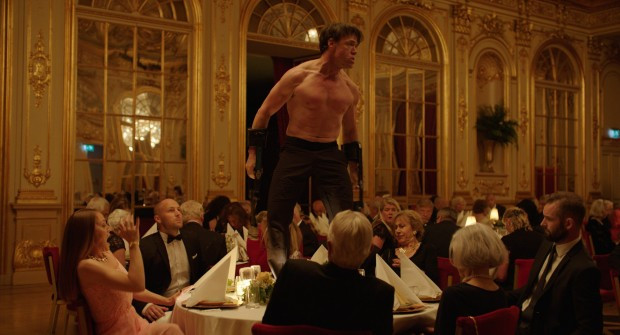CANNES FESTIVAL, Ruben Östlund’s THE SQUARE
[This film was awarded the Palme D’Or during the festival’s closing ceremony on May 28th, 2017]
Ruben Östlund’s “The Square” raised the overall level of this still-young Cannes Festival last night. Definitely my favorite film, so far. Will Yorgos Lanthimos’s film “The Killing of a Sacred Deer,” which screens later in the festival, knock “The Square” off the pole position? Perhaps. But for now let me bask in the euphoric weirdness of “The Square,” Östlund’s comeback film to Cannes after his “Force Majeure from a couple years ago, equally as strange film.
“The square” is everything that weird, nordic cinema can, and should, be. It should push you past your comfort zone, play with clichés (clichés can be fun to use in a movie, and useful), make us see something familiar in a new way, make us laugh and feel awkward doing it.
Central to “The Square” is the idea of our responsibility towards other human beings; our capacity for altruism. Christian (Danish actor Claes Bang, who made his reputation as actor in Germany) runs the city’s contemporary art museum. A divorcé who likes to spend time with his two daughters, Christian drives a Tesla and gives the beggars he encounters on his way to work handouts. Is he an altruist himself? Hard to tell. Probably. He is proud, handsome, and rich, that much we know.
The museum is preparing for an exhibit by the Argentine artist Lola Arias, so it’s all hands on deck. He organizes regular meetings with his associates and an ad agency is hired to put together a Youtube video that everyone hopes will go viral to prepare for the exhibit. The theme of the Arias show is altruism and its centerpiece a square, a simple square drawn into the ground outside the museum and also inside the museum. The idea being that, once you step into the square you’re in a safe space and if anything happens to you people will come to your rescue. Something happens to Christian personally and chaos follows.
Östlund’s aim with “The Square” is to put characters into situations in which they unravel, to see what happens after that. There are times when Östlund is facile, even cheap, creating these situations. In one scene, an artist (Dominic West) is interviewed on stage by someone. Their talk is constantly interrupted by someone in the audience who has a case of Tourette’s, a pretty nasty one. His repeated outbursts, the insults, are maddening and people in the audience laugh uncomfortably, until someone rises to Tourette Man’s defense and explains that this is a disorder and that there isn’t anything he can do about it and people should stop making fun of him. This scene could be a standalone sketch but does not add anything to the film, necessarily.
Images in this and previous Östlund movies are bright and crisp, adding realism and immediacy. And Östlund has a jarring way of setting up his shots. For example, if there’s a conversation between several people, Östlund’s camera will linger a much too long on the face of the person doing the listening, rather than the speaking. Or his lens may rest on a piece of furniture and take its time while there.
A strange incident takes place, after Christian gets his iPhone stolen. He tracks it, using the iPhone’s internal tracking app. A letter is prepared with the help of a young associate. In it, Christian makes a plea for whoever took the phone to drop it off at a local 7/11 (they have 7/11s in Sweden), or else. Threats are made. They drive in Christian’s Tesla to the building where the pings were emitted from. It’s very silly. Why would a museum executive driving a Tesla need to go through all this trouble to get his iPhone back, when he could just have his assistant call one of those concierge services that CEOs often use to cut through all the red tape? Is it a matter of personal pride?
Where Östlund’s off-kilter humor is lavished on full display in “The Square” is in a scene that takes place at a gala dinner to benefit the museum. As part of the night’s entertainment Christian planned some performance art, a man (actor Terry Notary) playing a gorilla. He walks around the well-adorned dinner tables, roars and howls. The impression is so accurate that it is disturbing, and even mildly unpleasant. He surveys the audience, jumps on a table, does his monkey screams, then pulls a woman by the hair and attempts to rape her. There’s something acutely unpleasant going on in this scene, and what fascinated me was how much I felt like I was drawn inside the movie, into the dining-room, and made to suffer through this along with the people at the gala.
“The Square” is a fascinating and original film. If the Cannes Festival were to hold its closing ceremony today I’d venture that “The Square” would land the Palme D’Or.
Pedro Almodovar

Michelle Dockery







